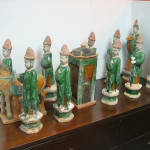Ming Dynasty Green and Yellow Glazed Pottery Sedan Chair Set, 1368 CE - 1644 CE
Terracotta
18.5
DL.2104
Upon leading a victorious rebellion against the foreign Mongul rulers of the Yuan Dynasty, a peasant named Zhu Yuanzhang seized control of China and founded the Ming Dynasty in 1368....
Upon leading a victorious rebellion against the foreign Mongul rulers of the Yuan Dynasty, a peasant named Zhu Yuanzhang seized control of China and founded the Ming Dynasty in 1368. As emperor, he founded his capital at Nanjing and adopted the name Hongwu as his reign title. Hongwu, literally meaning “vast military,” reflects the increased prestige of the army during the Ming Dynasty. Due to the very realistic threat still posed by the Mongols, Hongwu realized that a strong military was essential to Chinese prosperity. Thus, the orthodox Confucian view that the military was an inferior class to be ruled over by an elite class of scholars was reconsidered. During the Ming Dynasty, China proper was reunited after centuries of foreign incursion and occupation. Ming troops controlled Manchuria, and the Korean Joseon Dynasty respected the authority of the Ming rulers, at least nominally.
Like the founders of the Han Dynasty (206 B.C.
-220 A.D.), Hongwu was extremely suspicious of the educated courtiers that advised him and, fearful that they might attempt to overthrow him, he successfully consolidated control of all aspects of government. The strict authoritarian control Hongwu wielded over the affairs of the country was due in part to the centralized system of government he inherited from the Monguls and largely kept intact. However, Hongwu replaced the Mongul bureaucrats who had ruled the country for nearly a century with native Chinese administrators. He also reinstituted the Confucian examination system that tested would-be civic officials on their knowledge of literature and philosophy. Unlike the Song Dynasty (960-1279 A.D.), which received most of its taxes from mercantile commerce, the Ming economy was based primarily on agriculture, reflecting both the peasant roots of its founder as well as the Confucian belief that trade was ignoble and parasitic.
Culturally, the greatest innovation of the Ming Dynasty was the introduction of the novel. Developed from the folk tales of traditional storytellers, these works were transcribed in the everyday vernacular language of the people. Advances in printmaking and the increasing population of urban dwellers largely contributed to the success of these books. Architecturally, the most famous monument of the Ming Dynasty is surely the complex of temples and palaces known as the Forbidden City that was constructed in Beijing after the third ruler of the Ming Dynasty, Emperor Yongle, moved the capital there. Today, the Forbidden Palace remains one of the hallmarks of traditional Chinese architecture and is one of the most popular tourist destinations in the vast nation.
This miniature procession consists of 8 attendants, a horse and palanquin and a couple carrying offerings. The figures are dressed in emerald green robes, tied at the waist and lined with amber cloth. Conical red caps add to the dignity of the procession. The set reflects contemporary social practice; such processions were demanded by the emperor when tribute was delivered. The screens of the elegant sedan chair are adorned with diagonal hatching; this was the most common form of transport for the elite during this period. According to the conventions of Ming statuette art, each figure has an individual expression and it is likely that the attendants once carried banners or similar ceremonial objects. The glazed bases add to the detail of this charming set.
Like the founders of the Han Dynasty (206 B.C.
-220 A.D.), Hongwu was extremely suspicious of the educated courtiers that advised him and, fearful that they might attempt to overthrow him, he successfully consolidated control of all aspects of government. The strict authoritarian control Hongwu wielded over the affairs of the country was due in part to the centralized system of government he inherited from the Monguls and largely kept intact. However, Hongwu replaced the Mongul bureaucrats who had ruled the country for nearly a century with native Chinese administrators. He also reinstituted the Confucian examination system that tested would-be civic officials on their knowledge of literature and philosophy. Unlike the Song Dynasty (960-1279 A.D.), which received most of its taxes from mercantile commerce, the Ming economy was based primarily on agriculture, reflecting both the peasant roots of its founder as well as the Confucian belief that trade was ignoble and parasitic.
Culturally, the greatest innovation of the Ming Dynasty was the introduction of the novel. Developed from the folk tales of traditional storytellers, these works were transcribed in the everyday vernacular language of the people. Advances in printmaking and the increasing population of urban dwellers largely contributed to the success of these books. Architecturally, the most famous monument of the Ming Dynasty is surely the complex of temples and palaces known as the Forbidden City that was constructed in Beijing after the third ruler of the Ming Dynasty, Emperor Yongle, moved the capital there. Today, the Forbidden Palace remains one of the hallmarks of traditional Chinese architecture and is one of the most popular tourist destinations in the vast nation.
This miniature procession consists of 8 attendants, a horse and palanquin and a couple carrying offerings. The figures are dressed in emerald green robes, tied at the waist and lined with amber cloth. Conical red caps add to the dignity of the procession. The set reflects contemporary social practice; such processions were demanded by the emperor when tribute was delivered. The screens of the elegant sedan chair are adorned with diagonal hatching; this was the most common form of transport for the elite during this period. According to the conventions of Ming statuette art, each figure has an individual expression and it is likely that the attendants once carried banners or similar ceremonial objects. The glazed bases add to the detail of this charming set.



